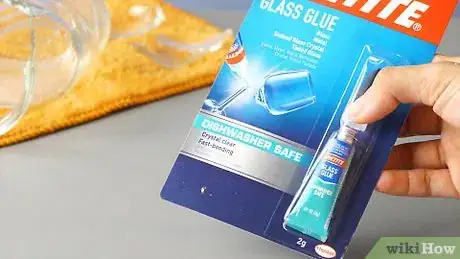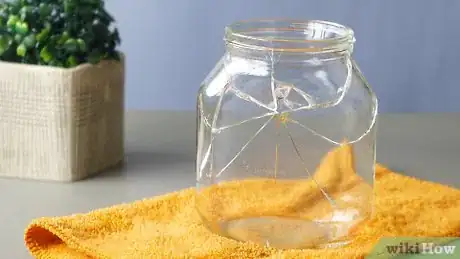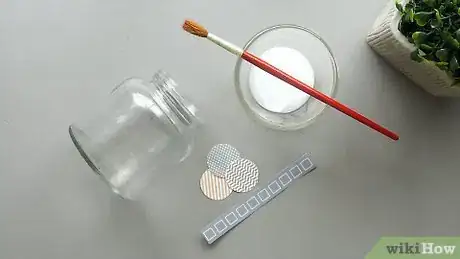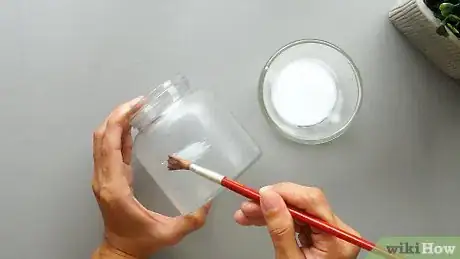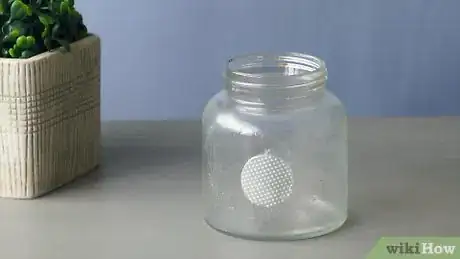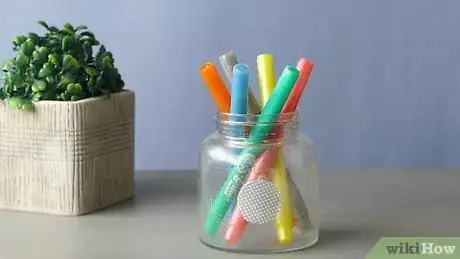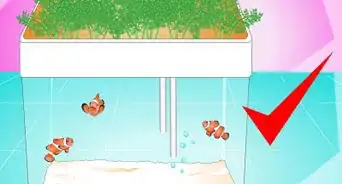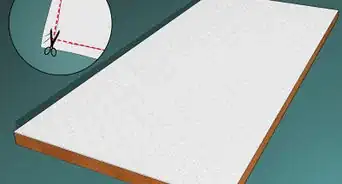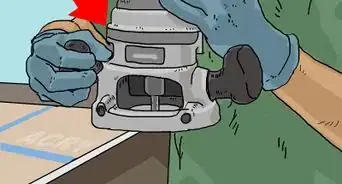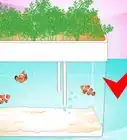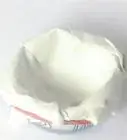wikiHow is a “wiki,” similar to Wikipedia, which means that many of our articles are co-written by multiple authors. To create this article, 20 people, some anonymous, worked to edit and improve it over time.
The wikiHow Video Team also followed the article's instructions and verified that they work.
This article has been viewed 684,384 times.
Learn more...
Do you have a broken glass vase or want to add some pizazz to your next glass art project? With some extra preparation or specialized glue, you'll be able to complete those glass-based projects without any trouble at all and without making a sticky mess! This wikiHow article will teach you how to glue glass with ease!
Steps
Repair a Fracture
-
1Select a glue. You'll need a specialized glue made to bond with glass, or the glass will come apart again as soon as it is cleaned.
- Silicone based adhesives are transparent and strong once dry, but can be toxic.[1] Aquarium glues fall under this category.
- Ultraviolet (UV) curing acrylic resins are excellent for repairing clear glass fragments that fit snugly together. They require exposure to sunlight or a UV lamp to set.[2] Opaque or colored glass may block some of the UV light, causing a weaker bond.
- If you are repairing an object that will be exposed to water, make sure the glue is waterproof. Most silicone adhesives and some UV resins are waterproof.
- If you are repairing an object that will come into contact with food or drink, check that the glue used is made for this purpose. Some adhesives are toxic even when dry.
-
2Clean both pieces with soap and water. After cleaning, wipe each piece dry thoroughly with a clean cloth. The pieces will bond best if they are clean, dry, and oil-free.
- Wear latex gloves while preparing and gluing the surfaces. This will prevent oil from your hands from rubbing off on the glass, and protect you from toxic or messy adhesives.
- Difficult stains can be scrubbed off using steel wool.[3]
Advertisement -
3Apply glue along one of the broken edges. You only need a small amount, but make sure the entire broken edge is covered. You only need to apply glue to one of the broken pieces.
-
4Press the two pieces together. Ensure the broken surfaces are aligned and hold in place for at least one minute.
-
5Allow the glue to set. This will take somewhere between a few minutes and 24 hours depending on the type and brand of glue. Even once it seems firm, avoid applying significant force for 24 hours.
- UV curing adhesives require exposure to ultraviolet light. A few minutes in direct, bright sunlight or under a UV lamp should harden the glue. Allow more time for opaque glass or less intense sunlight.
- Silicone based glues require several hours at least to set. They do not require sunlight and will set in most weather conditions (5%–95% humidity; 40º–100ºF=5º-40ºC).[4]
- For large flat pieces of glass, fix them in place with a glass clamp or another clamp specialized for holding fragile objects. Avoid cracking the glass through over-tightening.
-
6Shave away any excess glue with a razor blade. Check in on the glass before it's done setting. Excess glue may have oozed out of the joint and begun to dry. Carefully shave away this excess glue with a razor blade and wipe the surrounding area clean.
- Both UV and silicone glues will dry completely clear, so the fracture should be well concealed.
Decorate Glass
-
1Decide on materials and glue. You could decorate a glass jar with fabric or paper cutouts, or make a 3D mosaic by placing ceramic or glass tiles over a flower vase. Each combination of two materials can only be bonded by specific glues.
- Browse your hardware store or art supply store and read the glue labels to see which one is suitable for the materials you chose.
- A glue that dries clear is preferable for most art projects.
-
2Prepare your materials. A few simple steps will quicken the decorating process and ensure that the glass bonds strongly.
- Wash the glass thoroughly with soap and water.
- Dry the glass with a clean paper towel.
- Empty some glue into a plastic container. This will make it easy to apply with a paintbrush, and cause it to dry slightly for a useful tacky consistency.
-
3Paint a thin layer of glue over the object. Cover any areas you intend to decorate. Wipe off any excess blobs and wait for it to dry.[5]
- The setting time for the glue varies depending on the type of glue used. In most cases 5-10 minutes should be enough.
-
4Apply a second layer of glue to a small area. Once the first coat has dried, adding a small amount of glue to an area will make it wet and tacky, preventing your decorations from slipping.
- Wait another 5-10 minutes for this to take effect.
-
5Attach your decorations to the prepared area. If they slide off, wait for the glue to dry a little more and try again.[6]
- Apply, wait, and decorate each area in turn. Feel free to apply glue to a new area while you're still decorating the previous one.
-
6Add a last layer of glue over your decorations to seal them in. Let dry.
-
7Spray with a sealant to ensure durability and water resistance. Let dry for 15 minutes.
-
8Wipe off excess glue and let dry. Allow the glue to stand 24 hours before handling the object roughly, then enjoy your new decoration!
-
9Finished!
Community Q&A
-
QuestionHow can I glue handles on a wine glass?
 Community AnswerYou glue handles on a wine glass with glue. There is Gorilla Super Glue, Loctite Glass Super Glue, or E-6000 2oz Clear Industrial Strength Glue. These basic glues are fine but the best adhesive or bonding agent for glass is known as an epoxy. Epoxy is made to use for almost any surface.
Community AnswerYou glue handles on a wine glass with glue. There is Gorilla Super Glue, Loctite Glass Super Glue, or E-6000 2oz Clear Industrial Strength Glue. These basic glues are fine but the best adhesive or bonding agent for glass is known as an epoxy. Epoxy is made to use for almost any surface. -
QuestionCan you use a hot glue on glass?
 Community AnswerYes, but a low-temp hot glue gun would be safer than a high-temp hot glue gun. If the glue is too hot, you could break the glass.
Community AnswerYes, but a low-temp hot glue gun would be safer than a high-temp hot glue gun. If the glue is too hot, you could break the glass. -
QuestionHow do I glue two glass jars together?
 Community AnswerThe best adhesive or bonding agent for glass is known as an epoxy. Epoxy is made to glue almost any type of material. But basic glues such as Gorilla Super Glue, Loctite 349 Glass to Glass Glue, and E-6000 Clear Industrial Strength Glue are all good types to use when trying to do that. You can find them in most hardware stores. Be patient and careful when gluing, since glass is probably one of the most satiny and unsafe things to use.
Community AnswerThe best adhesive or bonding agent for glass is known as an epoxy. Epoxy is made to glue almost any type of material. But basic glues such as Gorilla Super Glue, Loctite 349 Glass to Glass Glue, and E-6000 Clear Industrial Strength Glue are all good types to use when trying to do that. You can find them in most hardware stores. Be patient and careful when gluing, since glass is probably one of the most satiny and unsafe things to use.
Things You'll Need
Repairing a fracture:
- UV or silicone glue
- Soap
- Water
- Clean cloth
- Latex gloves
- UV lamp or sunlight (for UV resins)
- Razor blade
- Clamp (optional, to hold large pieces)
- Steel wool (optional, for cleaning)
Warnings
- Work in a well-ventilated area if you are using an adhesive that produces toxic fumes.⧼thumbs_response⧽
References
- ↑ https://ferris.msdssoftware.com/ImageDir/i011B3A3.pdf
- ↑ http://mikegigi.com/glues.htm#CATEG
- ↑ https://www.youtube.com/watch?v=U3k49qMBhOc
- ↑ https://pmsilicone.com/using-silicone-winter/
- ↑ https://www.youtube.com/watch?v=ejlm5VgavDQ
- ↑ https://www.youtube.com/watch?v=ejlm5VgavDQ
- ↑ https://www.youtube.com/watch?v=lt8TtoIVDt0
About This Article
To repair broken glass, squeeze a thin line of strong, non-toxic glue along the edge or, For decorative glass, use a silicon-based or UV-curing resin. Press the pieces together firmly, then let the glue set for 24 hours. For more glue options and ways to use glue to decorate your repaired glass, keep reading!
